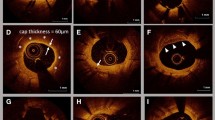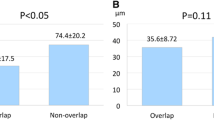Abstract
Tortuous coronary lesions are associated with adverse outcomes after implantation of bare metal or first-generation drug-eluting stents (DESs). We investigated the impact of lesion angle on vessel wall injuries and stent apposition as assessed by optical coherence tomography (OCT) after second- and newer-generation DES implantation. We investigated 95 de novo lesions treated with a single DES (62 platinum-chromium everolimus-eluting stents and 33 bioresorbable-polymer sirolimus-eluting stents). Post-intervention OCT findings were compared between angled lesions (≥ 45°; n = 33) and non-angled lesions (< 45°; n = 62). The 12-month clinical outcomes were also compared between the groups. Cross-sectional OCT analysis revealed that compared to non-angled lesions, angled ones had a significantly higher incidence of intra-stent dissection around the centre of the angle (19.7% vs. 10.8%, p = 0.01) and incomplete stent apposition (ISA) in the distal and proximal sub-segments (10.0% vs. 4.1%, p = 0.002; 15.3% vs. 7.9%, p < 0.001, respectively). Strut-based analysis also showed that angled lesions demonstrated a higher rate of malapposed strut in the distal and proximal sub-segments (3.0% vs. 0.9%, p < 0.001; 4.3% vs. 1.8%, p < 0.001, respectively). The 12 month clinical outcomes were comparable between the groups. Compared to non-angled lesions, angled coronary lesions were associated with a higher incidence of intra-stent dissection and ISA on post-intervention OCT after implantation of second- and newer-generation DESs.




Similar content being viewed by others
References
Morice MC, Serruys PW, Sousa JE et al (2002) A randomized comparison of a sirolimus-eluting stent with a standard stent for coronary revascularization. N Engl J Med 346(23):1773–1780
Dangas GD, Claessen BE, Caixeta A et al (2010) In-stent restenosis in the drug-eluting stent era. J Am Coll Cardiol 56(23):1897–1907
Stone GW, Moses JW, Ellis SG et al (2007) Safety and efficacy of sirolimus- and paclitaxel-eluting coronary stents. N Engl J Med 356(10):998–1008
Park SM, Kim JY, Hong BK et al (2011) Predictors of stent fracture in patients treated with closed-cell design stents: sirolimus-eluting stent and its bare-metal counterpart, the BX velocity stent. Coron Artery Dis 22(1):40–44
Ino Y, Kubo T, Kitabata H, Shimamura K et al (2011) Impact of hinge motion on in-stent restenosis after sirolimus-eluting stent implantation. Circ J 75(8):1878–1884
Minami Y, Ong DS, Uemura S et al (2015) Impacts of lesion angle on incidence and distribution of acute vessel wall injuries and strut malapposition after drug-eluting stent implantation assessed by optical coherence tomography. Eur Heart J Cardiovasc Imaging 16(12):1390–1398
Menown IB, Noad R, Garcia EJ, Meredith I (2010) The platinum chromium element stent platform: from alloy, to design, to clinical practice. Adv Ther 27(3):129–141
Chevalier B, Smits PC, Carrie D et al (2017) Serial assessment of strut coverage of biodegradable polymer drug-eluting stent at 1, 2, and 3 months after stent implantation by optical frequency domain imaging: the discovery 1TO3 study (evaluation with OFDI of strut coverage of terumo new drug eluting stent with biodegradable polymer at 1, 2, and 3 months). Circ Cardiovasc Interv 10(12):e004801. https://doi.org/10.1161/circinterventions.116.004801
Sugiyama T, Kimura S, Ohtani H et al (2017) Impact of chronic kidney disease stages on atherosclerotic plaque components on optical coherence tomography in patients with coronary artery disease. Cardiovasc Interv Ther 32(3):216–224
Tanigawa J, Barlis P, Di Mario C (2007) Intravascular optical coherence tomography: optimisation of image acquisition and quantitative assessment of stent strut apposition. EuroIntervention 3(1):128–136
Otake H, Shite J, Ako J et al (2009) Local determinants of thrombus formation following sirolimus-eluting stent implantation assessed by optical coherence tomography. JACC Cardiovasc Interv 2(5):459–466
De Cock D, Bennett J, Ughi GJ et al (2014) Healing course of acute vessel wall injury after drug-eluting stent implantation assessed by optical coherence tomography. Eur Heart J Cardiovasc Imaging 15(7):800–809
Mattesini A, Secco GG, Dall’Ara G, et al (2014) ABSORB biodegradable stents versus second-generation metal stents: a comparison study of 100 complex lesions treated under OCT guidance. JACC Cardiovasc Interv 7(7):741–750
Zhang S, Dai J, Jia H et al (2018) Non-culprit plaque characteristics in acute coronary syndrome patients with raised hemoglobinA1c: an intravascular optical coherence tomography study. Cardiovasc Diabetol 17(1):90
Tanaka A, Imanishi T, Kitabata H et al (2009) Lipid-rich plaque and myocardial perfusion after successful stenting in patients with non-ST-segment elevation acute coronary syndrome: an optical coherence tomography study. Eur Heart J 30(11):1348–1355
Cutlip DE, Windecker S, Mehran R et al (2007) Clinical end points in coronary stent trials: a case for standardized definitions. Circulation 115(17):2344–2351
Wu W, Wang WQ, Yang DZ, Qi M (2007) Stent expansion in curved vessel and their interactions: a finite element analysis. J Biomech 40(11):2580–2585
Kuramitsu S, Hiromasa T, Enomoto S et al (2015) Incidence and clinical impact of stent fracture after PROMUS element platinum chromium everolimus-eluting stent implantation. JACC Cardiovasc Interv 8(9):1180–1188
Gyongyosi M, Yang P, Khorsand A, Glogar D (2000) Longitudinal straightening effect of stents is an additional predictor for major adverse cardiac events. Austrian Wiktor Stent study group and European Paragon Stent investigators. J Am Coll Cardiol 35(6):1580–1589
Taniwaki M, Radu MD, Zaugg S et al (2016) Mechanisms of very late drug-eluting stent thrombosis assessed by optical coherence tomography. Circulation 133(7):650–660
Gutierrez-Chico JL, Wykrzykowska J, Nuesch E et al (2012) Vascular tissue reaction to acute malapposition in human coronary arteries: sequential assessment with optical coherence tomography. Circ Cardiovasc Interv 5(1):20–29
Inoue T, Shinke T, Otake H et al (2014) Impact of strut-vessel distance and underlying plaque type on the resolution of acute strut malapposition: serial optimal coherence tomography analysis after everolimus-eluting stent implantation. Int J Cardiovasc Imaging 30(5):857–865
Mortier P, De Beule M, Segers P, Verdonck P, Verhegghe B (2011) Virtual bench testing of new generation coronary stents. EuroIntervention 7(3):369–376
Mortier P, Holzapfel GA, De Beule M et al (2010) A novel simulation strategy for stent insertion and deployment in curved coronary bifurcations: comparison of three drug-eluting stents. Ann Biomed Eng 38(1):88–99
Author information
Authors and Affiliations
Corresponding author
Ethics declarations
Conflict of interest
The authors declare that they have no conflict of interest.
Additional information
Publisher's Note
Springer Nature remains neutral with regard to jurisdictional claims in published maps and institutional affiliations.
Electronic supplementary material
Below is the link to the electronic supplementary material.
Rights and permissions
About this article
Cite this article
Nakamura, S., Kimura, S., Nakagama, S. et al. Impact of lesion angle on optical coherence tomography findings and clinical outcomes after drug-eluting stent implantation in curved vessels. Int J Cardiovasc Imaging 35, 2147–2155 (2019). https://doi.org/10.1007/s10554-019-01679-6
Received:
Accepted:
Published:
Issue Date:
DOI: https://doi.org/10.1007/s10554-019-01679-6




